Phosphates Induced H-Type or J-Type Aggregation of Cationic Porphyrins with Varied Side Chains
Abstract
1. Introduction
2. Results
3. Discussion
4. Materials and Methods
5. Conclusions
Supplementary Materials
Author Contributions
Funding
Institutional Review Board Statement
Informed Consent Statement
Data Availability Statement
Acknowledgments
Conflicts of Interest
Sample Availability
References
- Aida, T.; Meijer, E.; Stupp, S. Functional supramolecular polymers. Science 2012, 335, 813–817. [Google Scholar] [CrossRef]
- Grzybowski, B.A.; Huck, W.T. The nanotechnology of life-inspired systems. Nat. Nanotechnol. 2016, 11, 585. [Google Scholar] [CrossRef] [PubMed]
- Helmich, F.; Lee, C.C.; Nieuwenhuizen, M.M.; Gielen, J.C.; Christianen, P.; Larsen, A.; Fytas, G.; Leclère, P.E.; Schenning, A.P.; Meijer, E. Dilution-Induced Self-Assembly of Porphyrin Aggregates: A Consequence of Coupled Equilibria. Angew. Chem. 2010, 122, 4031–4034. [Google Scholar] [CrossRef]
- Roman, M.; Cannizzo, C.; Pinault, T.; Isare, B.; Andrioletti, B.; Van Der Schoot, P.; Bouteiller, L. Supramolecular balance: Using cooperativity to amplify weak interactions. J. Am. Chem. Soc. 2010, 132, 16818–16824. [Google Scholar] [CrossRef] [PubMed]
- Liu, M.; Zhang, L.; Wang, T. Supramolecular Chirality in Self-Assembled Systems. Chem. Rev. 2015, 115, 7304–7397. [Google Scholar] [CrossRef]
- Yashima, E.; Ousaka, N.; Taura, D.; Shimomura, K.; Ikai, T.; Maeda, K. Supramolecular helical systems: Helical assemblies of small molecules, foldamers, and polymers with chiral amplification and their functions. Chem. Rev. 2016, 116, 13752–13990. [Google Scholar] [CrossRef]
- Rao, K.V.; Miyajima, D.; Nihonyanagi, A.; Aida, T. Thermally bisignate supramolecular polymerization. Nat. Chem. 2017, 9, 1133–1139. [Google Scholar] [CrossRef]
- Fukui, T.; Kawai, S.; Fujinuma, S.; Matsushita, Y.; Yasuda, T.; Sakurai, T.; Seki, S.; Takeuchi, M.; Sugiyasu, K. Control over differentiation of a metastable supramolecular assembly in one and two dimensions. Nat. Chem. 2017, 9, 493–499. [Google Scholar] [CrossRef]
- Ogi, S.; Sugiyasu, K.; Manna, S.; Samitsu, S.; Takeuchi, M. Living supramolecular polymerization realized through a biomimetic approach. Nat. Chem. 2014, 6, 188. [Google Scholar] [CrossRef]
- Mabesoone, M.F.; Markvoort, A.J.; Banno, M.; Yamaguchi, T.; Helmich, F.; Naito, Y.; Yashima, E.; Palmans, A.R.; Meijer, E.W. Competing interactions in hierarchical porphyrin self-assembly introduce robustness in pathway complexity. J. Am. Chem. Soc. 2018, 140, 7810–7819. [Google Scholar] [CrossRef]
- Kasha, M.; Rawls, H.R.; Ashraf El-Bayoumi, M. The exciton model in molecular spectroscopy. Pure Appl. Chem. 1965, 11, 371–392. [Google Scholar] [CrossRef]
- Würthner, F.; Kaiser, T.E.; Saha-Möller, C.R. J-Aggregates: From Serendipitous Discovery to Supramolecular Engineering of Functional Dye Materials. Angew. Chem. Int. Ed. 2011, 50, 3376–3410. [Google Scholar] [CrossRef]
- Görl, D.; Zhang, X.; Würthner, F. Molecular assemblies of perylene bisimide dyes in water. Angew. Chem. Int. Ed. 2012, 51, 6328–6348. [Google Scholar] [CrossRef] [PubMed]
- Wei, P.; Yan, X.; Huang, F. Supramolecular polymers constructed by orthogonal self-assembly based on host–guest and metal–ligand interactions. Chem. Soc. Rev. 2015, 44, 815–832. [Google Scholar] [CrossRef]
- Dhiman, S.; Jain, A.; Kumar, M.; George, S.J. Adenosine-Phosphate-Fueled, Temporally Programmed Supramolecular Polymers with Multiple Transient States. J. Am. Chem. Soc. 2017, 139, 16568–16575. [Google Scholar] [CrossRef]
- Sorrenti, A.; Leira-Iglesias, J.; Sato, A.; Hermans, T.M. Non-equilibrium steady states in supramolecular polymerization. Nat. Commun. 2017, 8, 15899. [Google Scholar] [CrossRef] [PubMed]
- Dhiman, S.; Jain, A.; George, S.J. Transient Helicity: Fuel-Driven Temporal Control over Conformational Switching in a Supramolecular Polymer. Angew. Chem. Int. Ed. 2017, 129, 1349–1353. [Google Scholar] [CrossRef]
- Kumar, M.; Brocorens, P.; Tonnelé, C.; Beljonne, D.; Surin, M.; George, S.J. A dynamic supramolecular polymer with stimuli-responsive handedness for in situ probing of enzymatic ATP hydrolysis. Nat. Commun. 2014, 5, 5793. [Google Scholar] [CrossRef]
- Maity, D.; Hamilton, A.D. The helical supramolecular assembly of oligopyridylamide foldamers in aqueous media can be guided by adenosine diphosphates. Chem. Commun. 2021, 57, 9192–9195. [Google Scholar] [CrossRef]
- Li, Z.; Zeman, C.J.I.V.; Valandro, S.R.; Bantang, J.P.O.; Schanze, K.S. Adenosine Triphosphate Templated Self-Assembly of Cationic Porphyrin into Chiral Double Superhelices and Enzyme-Mediated Disassembly. J. Am. Chem. Soc. 2019, 141, 12610–12618. [Google Scholar] [CrossRef]
- Guo, Y.; Huang, S.; Sun, H.; Wang, Z.; Shao, Y.; Li, L.; Li, Z.; Song, F. Tuning the aqueous self-assembly of porphyrins by varying the number of cationic side chains. J. Mater. Chem. B 2022, 10, 5968–5975. [Google Scholar] [CrossRef]
- Li, Z.; Li, S.; Guo, Y.; Yuan, C.; Yan, X.; Schanze, K.S. Metal-Free Nanoassemblies of Water-Soluble Photosensitizer and Adenosine Triphosphate for Efficient and Precise Photodynamic Cancer Therapy. ACS Nano 2021, 15, 4979–4988. [Google Scholar] [CrossRef]
- Zhao, X.; Schanze, K.S. Fluorescent ratiometric sensing of pyrophosphate via induced aggregation of a conjugated polyelectrolyte. Chem. Commun. 2010, 46, 6075–6077. [Google Scholar] [CrossRef]
- Li, Z.; Acharya, R.; Wang, S.; Schanze, K. Photophysics and Phosphate Fluorescence Sensing by poly (phenylene ethynylene) Conjugated Polyelectrolytes with Branched Ammonium Side Groups. J. Mater. Chem. C 2018, 6, 3722–3730. [Google Scholar] [CrossRef]
- Hollingsworth, J.V.; Richard, A.J.; Vicente, M.G.H.; Russo, P.S. Characterization of the Self-Assembly of meso-Tetra (4-sulfonatophenyl) porphyrin (H2TPPS4–) in Aqueous Solutions. Biomacromolecules 2011, 13, 60–72. [Google Scholar] [CrossRef] [PubMed]
- Li, C.-H.; Chang, K.-C.; Tsou, C.-C.; Lan, Y.; Yang, H.-C.; Sun, S.-S. Chiral amplification in one-dimensional helical nanostructures self-organized from phenylethynyl thiophene with elaborated long-chain dicarboxamides. J. Org. Chem. 2011, 76, 5524–5530. [Google Scholar] [CrossRef]
- Wang, Y.; Fang, H.; Tranca, I.; Qu, H.; Wang, X.; Markvoort, A.J.; Tian, Z.; Cao, X. Elucidation of the origin of chiral amplification in discrete molecular polyhedra. Nat. Commun. 2018, 9, 488. [Google Scholar] [CrossRef] [PubMed]
- Amirbekyan, K.; Duchemin, N.; Benedetti, E.; Joseph, R.; Colon, A.; Markarian, S.A.; Bethge, L.; Vonhoff, S.; Klussmann, S.; Cossy, J. Design, Synthesis, and Binding Affinity Evaluation of Hoechst 33258 Derivatives for the Development of Sequence-Specific DNA-Based Asymmetric Catalysts. ACS Catal. 2016, 6, 3096–3105. [Google Scholar] [CrossRef]
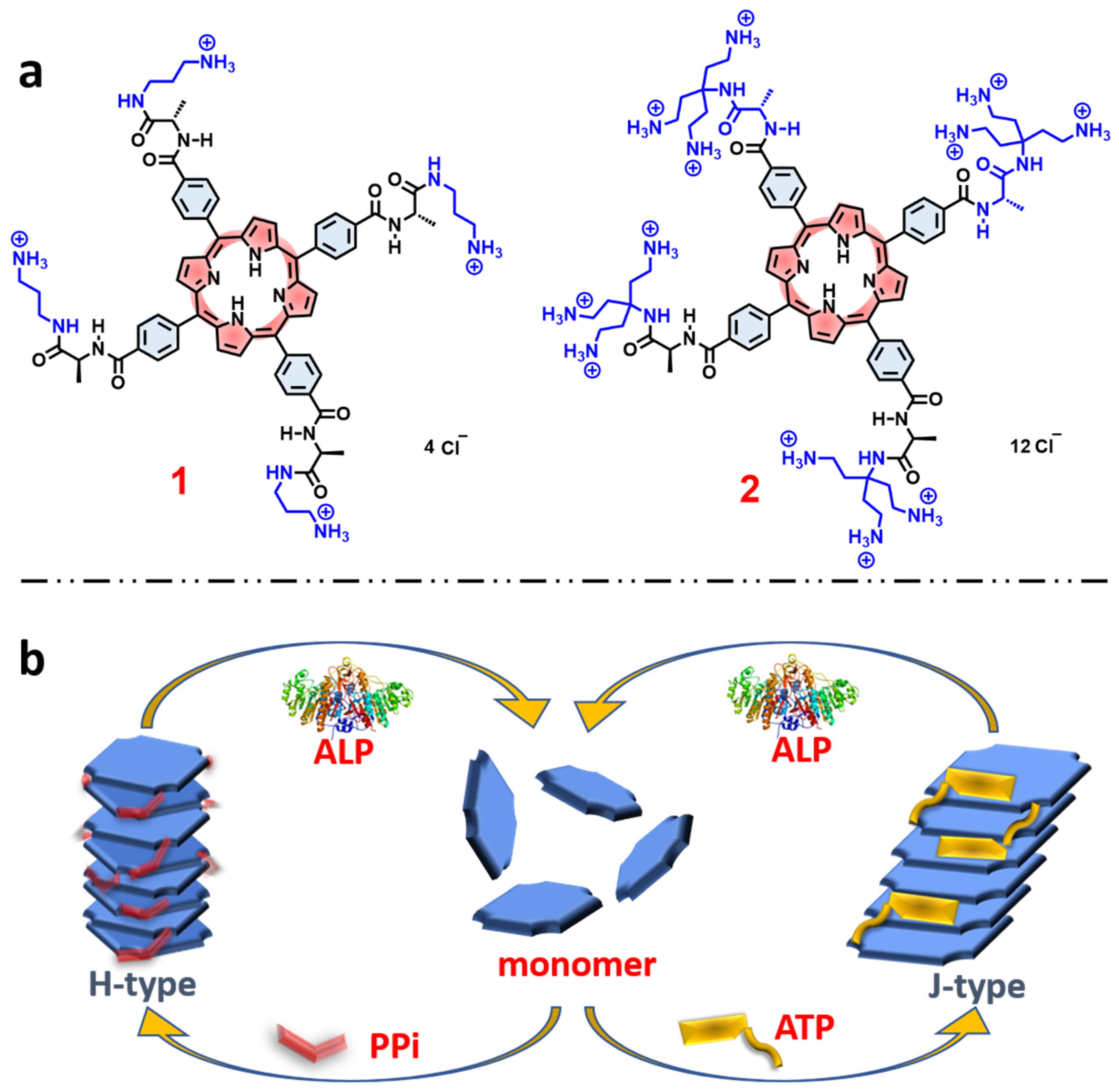
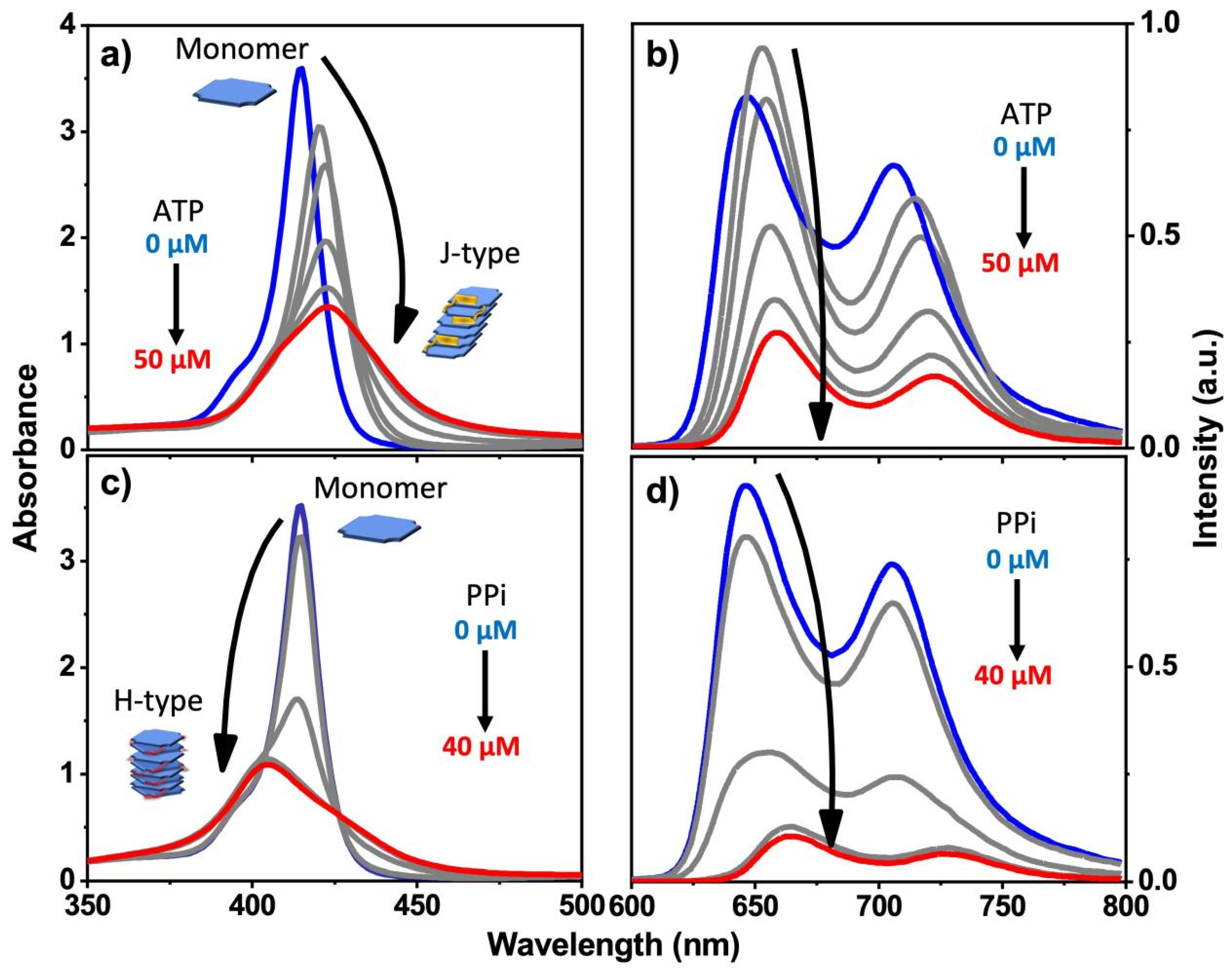
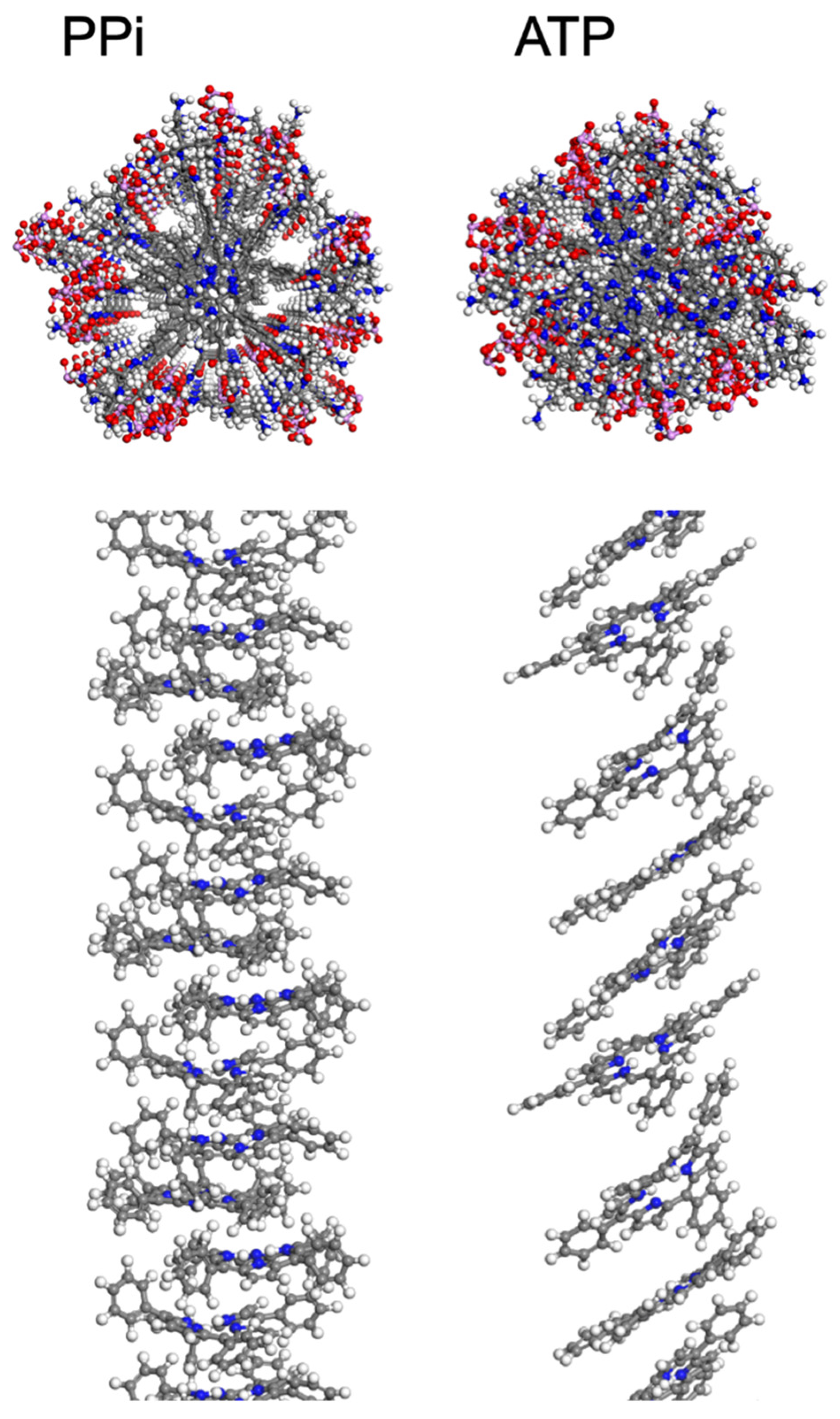
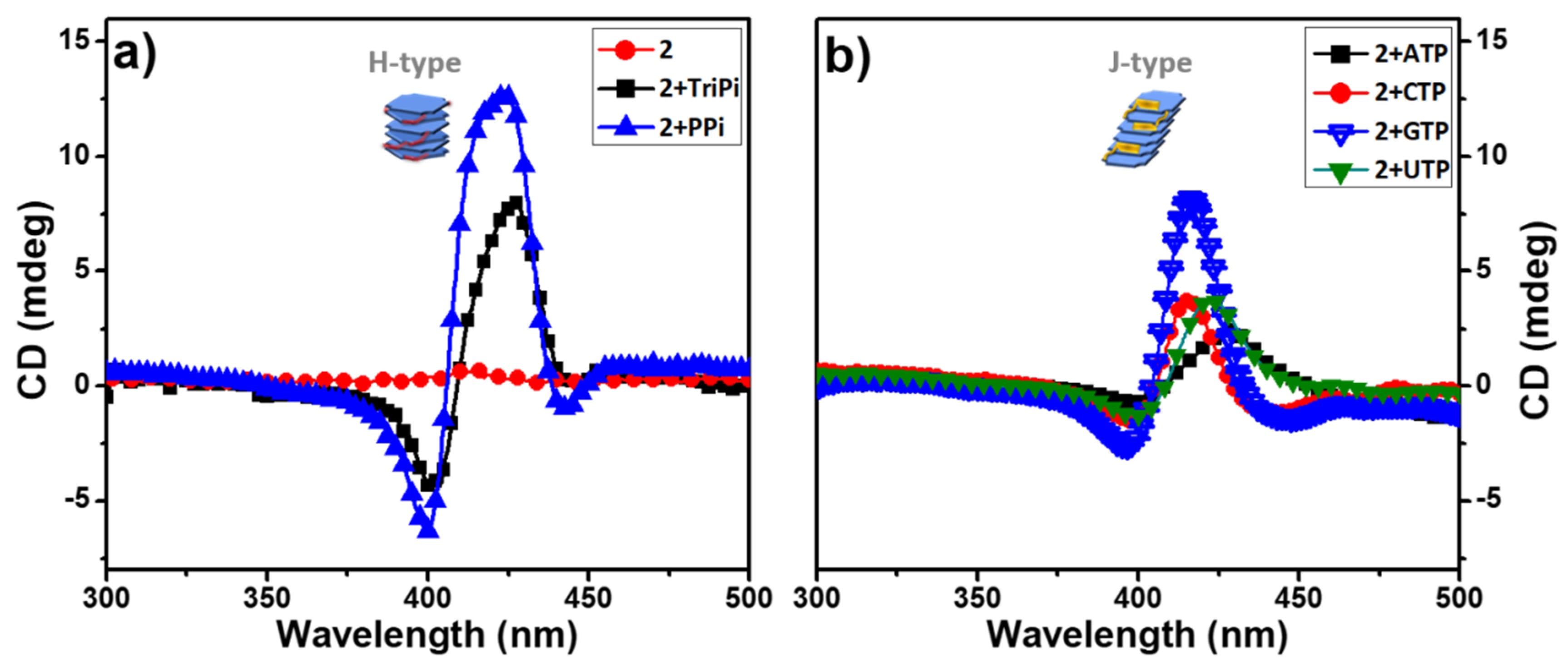
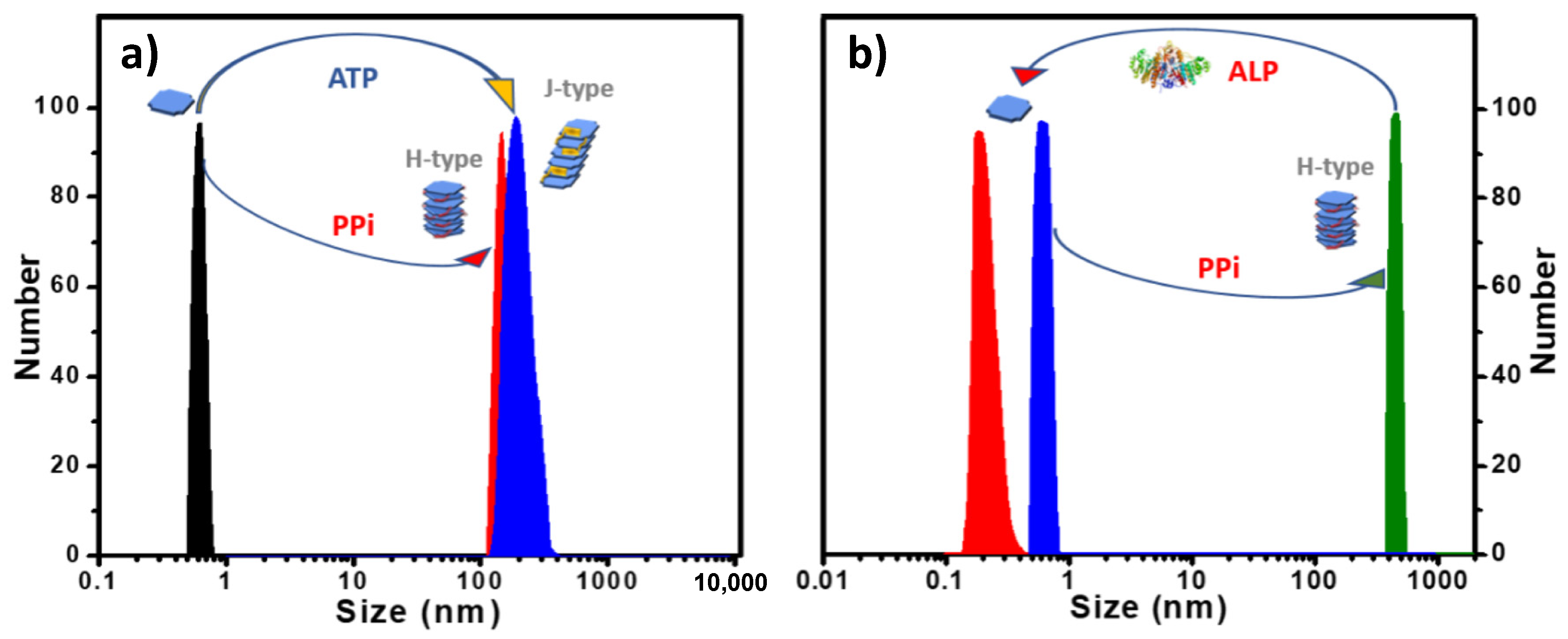
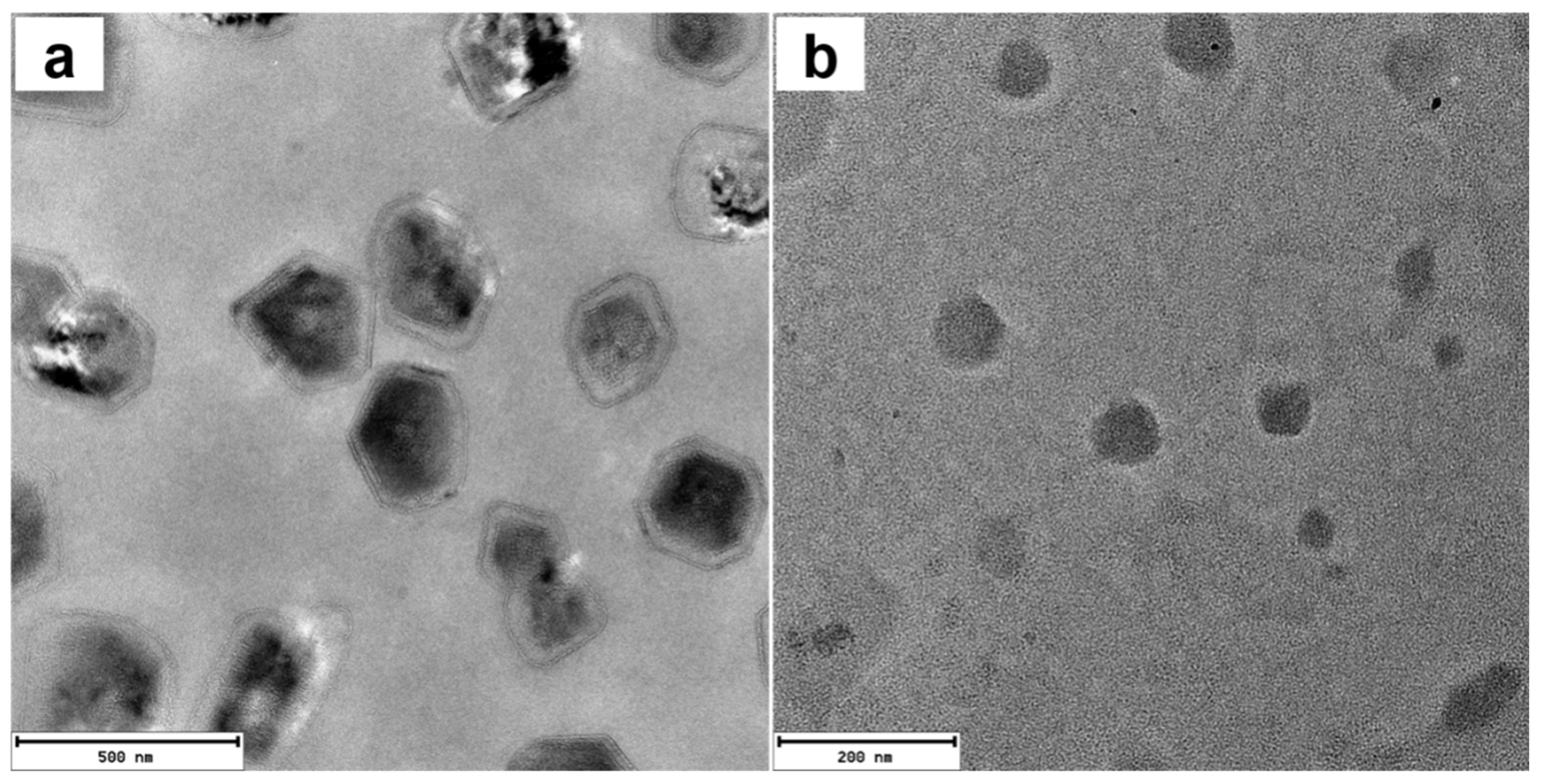
Disclaimer/Publisher’s Note: The statements, opinions and data contained in all publications are solely those of the individual author(s) and contributor(s) and not of MDPI and/or the editor(s). MDPI and/or the editor(s) disclaim responsibility for any injury to people or property resulting from any ideas, methods, instructions or products referred to in the content. |
© 2023 by the authors. Licensee MDPI, Basel, Switzerland. This article is an open access article distributed under the terms and conditions of the Creative Commons Attribution (CC BY) license (https://creativecommons.org/licenses/by/4.0/).
Share and Cite
Li, Z.; Zeman, C.J., IV; Valandro, S.; Bantang, J.P.O.; Schanze, K.S. Phosphates Induced H-Type or J-Type Aggregation of Cationic Porphyrins with Varied Side Chains. Molecules 2023, 28, 4115. https://doi.org/10.3390/molecules28104115
Li Z, Zeman CJ IV, Valandro S, Bantang JPO, Schanze KS. Phosphates Induced H-Type or J-Type Aggregation of Cationic Porphyrins with Varied Side Chains. Molecules. 2023; 28(10):4115. https://doi.org/10.3390/molecules28104115
Chicago/Turabian StyleLi, Zhiliang, Charles J. Zeman, IV, Silvano Valandro, Jose Paolo O. Bantang, and Kirk S. Schanze. 2023. "Phosphates Induced H-Type or J-Type Aggregation of Cationic Porphyrins with Varied Side Chains" Molecules 28, no. 10: 4115. https://doi.org/10.3390/molecules28104115
APA StyleLi, Z., Zeman, C. J., IV, Valandro, S., Bantang, J. P. O., & Schanze, K. S. (2023). Phosphates Induced H-Type or J-Type Aggregation of Cationic Porphyrins with Varied Side Chains. Molecules, 28(10), 4115. https://doi.org/10.3390/molecules28104115





